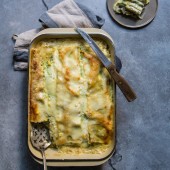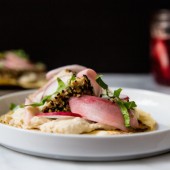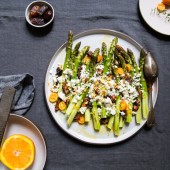For those of you who know my past history with food and cooking, you’ll know of my late-ish start at the ripe old age of 25. Before cooking, there was canned soup, preferably Chunky beef stew. And before that, I survived on falafel sandwiches from the deli, cheeseburgers, Harvey’s poutine because, yes, I’m Canadian, and that’s how we roll with fast food in high school.
But in my 20s, things magically changed. I picked up a chef’s knife for the first time and learned to wield my way through pounds of onions, mountains of garlic, and bushels of tomatoes.
My first few meals felt like a Herculean accomplishment. I’ll never forget the first Pad Thai that I made at my Dad’s house, mounded on a platter, decorated with cilantro and quartered limes. The creamy soup that I couldn’t wait to serve my first ever dinner guests. The mortification over missing the directions to take the soup off the heat before adding the dairy…rendering my velvet beast into a curdled nightmare, more reminiscent of Chinese egg drop soup than anything vaguely Italian-ish.
And I will never, ever forget that first risotto, my first real accomplishment in the kitchen. The smell of the white wine hitting the pan to deglaze the sweet onions. The homemade stock, ladled into the pan one loving spoonful at a time. Making risotto always transported me into my grandmother’s kitchen. Such a cliché admission these days, the reminiscing about kitchens that once were. The domain of family matriarchs whose immigrant kitchens spawned earnest food from the homeland.
But it’s truth, plain and simple. My Nana ran that oregano-infused kitchen with an iron fist. And she loved risotto. Her house smelled like risotto. And though she never got to see me cook, or learn of my passion for food, I always feel as though I’m channeling her spirit when I stand at the stove and stir. And stir. I sip wine and I stir.
A few weeks ago I had the pleasure of attending a dinner hosted by the feedfeed and Austerity Wines. Austerity had co-hosted an event in New York in the spring of ’17 and I’d remember getting pleasantly buzzed off of their velvety Cabarnet and a spicy Pinot Noir. This year I was game to try their wines again and was amped to start off the evening with sangria featuring their bright and tropical fruit-forward Chardonnay.
The dinner was effortlessly chic, cooked by chef Michael Chernow of Seamore’s restaurants in New York City. Winemaker Steven DeCosta spoke to us about Austerity’s production process and growing conditions for all of those lip-smacking grapes. Austerity’s Chardonnay comes from Monterey County’s Salinas Valley with its cool winds and warm midday sun, ideal growing conditions we learned. And as I teetered home after clinking glasses with some of my favorite NY cooks ), I started to brainstorm ideas for eating and pairing these jewels of the California wine country.
Starting with their Chardonnay- a bright and mineral flavor, perfectly paired with any spring meal. I confess that Chardonnay isn’t always my first choice when it comes to white wine – I find that an overly oaky taste is too much for my palate and tend to stick to grassier numbers – new world Sauvignon Blancs or a dry Pinot Gris. But I can enthusiastically get behind Austerity’s Chardonnay, smooth and buttery and with only a light oak flavor since much of the fermentation process happens in steel casks. It’s so enjoyable as a crisp drinking wine, that I almost considered not cooking with it and saving it for our Greenwood Lake sunset viewing sessions.
Almost.
Risotto was on my mind, as per usual. And just a splash of Chardonnay goes a long way to infuse the rice with a fruit-forward flavor, leaving the rest for me and my stirring/drinking habit.
So I bring you my twist on risotto – classic in its technique, ingredients riffed. Barley stands in for the rice, giving the risotto some extra heft. Slivered snap peas and blanched asparagus are spooned over the top. The bowls are then then garnished with pickled asparagus and flowering claytonia, a delicate spring lettuce with teensy white blooms. It’s spring in a bowl, with femininity to spare. Cheers to the barley, and the greens. To the Austerity Chardonnay that was folded into the dish and mainlined into my gullet. And cheers to a partnership that will be very much enjoyed this year. Stay tuned for more collaborations ahead with Austerity Wines.
This post was produced in conjunction with the feedfeed and Austerity wines. All opinions are my own.
Recipe
Ingredients
• 1 small bunch of asparagus
• ¼ cup rice wine vinegar
• Salt and black pepper, to taste
• 4 tablespoons of olive oil, divided
• 1.5 quarts of homemade chicken stock
• 1 medium onion, diced
• 1 cup of barley grains
• 1/3 cup of Austerity Chardonnay
• 1/3 cup of Parmesan cheese
• 1 small handful of sugar snap peas
• 2 tablespoons unsalted butter
• Small bunch claytonia (a flowering green, feel free to sub. any other spring herbs or lettuces)
Instructions
1. Cut the tips off the asparagus and set aside to be blanched later. Snap off the woody stems, and then take a vegetable peeler and peel the asparagus bases into long strips. Place in a small bowl and cover with the vinegar and a large pinch of salt, adding a little more vinegar if necessary to cover. Toss every so often until the asparagus stems become softened.
2. While the asparagus is pickling, make the risotto. Heat your chicken stock to a simmer. In a large sauté pan, heat the remaining 2 tablespoons of olive oil on medium heat, and then add your onion. Cook the onion until translucent (approximately 5-7 minutes). Add your barley, and stir in the onions until well coated, and toast in the oil for a minute or so. Reduce your heat to low.
3. Add the Austerity Chardonnay, and cook until the wine has been incorporated into the grains (a minute or so), and then ladle in your first cup of the simmering broth. Cook, stirring so often, until the liquid has been absorbed. Once absorbed, add another ladle of stock. Continue this process until the barley has become tender. Given that barley is always slightly chewy, it will never get totally soft, but you’ll know when the grain has become pleasantly tender instead of tough to chew. The process will take about 45 mins to an hour.
4. While the risotto is cooking, blanch the asparagus tops and the slivered peas in boiling salted water for 1 minute, and then rinse under cold water. Set aside.
5. When the risotto has cooked fully, season with salt and pepper to taste and add most of the Parmesan cheese (leave a few tablespoons to top at the table). Add the butter. Taste once more for seasoning, adding more salt and pepper to taste if necessary.
6. Ladle the risotto into bowls and then top with the pea/asparagus mixture, the pickled asparagus and the flowering claytonia (or other herbs).
7. Serve alongside some Austerity Chardonnay!

























What beautiful photos. That risotto looks fabulous. I’m definitely going to make it????????????
This risotto looks delicious – I love how you subbed in the barley, it must be delicious! Gorgeous photos too – cheers!
Food with wine such a great combination. It is a lot of fun if friends with you. With the wine table, we share or talk to gather and the life moments we share with each other. Overall thanks for decanter sharing your experience with us it helps many people to survive and enjoy in college life. These moments can make the best memories of life.
Austerity is the best brand of wine in the world. Wine with food is the best combination. Many people in the world enjoy wine with their meals. All the instructions that you mention in the article are informative. It must be delicious.